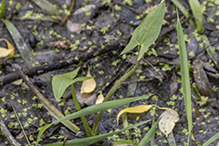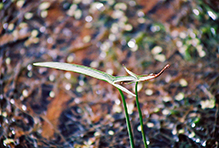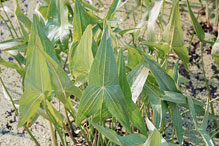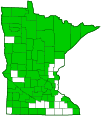arumleaf arrowhead
(Sagittaria cuneata)
Conservation • Wetland • Description • Habitat • Ecology • Use • Distribution • Taxonomy
Description |
||
Arumleaf arrowhead is an erect or floating, perennial, emergent, aquatic forb that rises on a rosette of leaves and a single flowering stem from a tuft of coarse roots. It is found in water up to 3′ deep and emerges above the water up to 24″. The roots are tipped with starchy tubers (corms). The plant spreads by long, creeping, above-ground, horizontal stems (stolons), and it often forms dense colonies. The leaves emerge from the water on long stalks (petioles). The petioles are stout, erect to ascending, and about as long as the water is deep. They are triangular in cross section for most of their length, round near the base. They are somewhat inflated and sheath the stem at the base. They are sometimes bent downward near the top. The leaves may be submerged, floating, or held above the water (emersed). When the leaf is submerged there is no true leaf blade. In place of the leaf the end of the petiole is flattened, very long and narrow (linear), often ribbon-shaped, and up to 18″ long. When floating, the leaf blade is small, normally heart-shaped or arrow-shaped, rarely linear or egg-shaped, 2¾″ to 3″ long, and 1⅜″ to 1⅝″ wide. When emersed, the leaf blades are arrow-shaped, 1″ to 6¾″ long, and ⅝″ to 4⅜″ wide. The lobes at the base of the blade point downward, not outward, and are much shorter than the rest of the blade. The tip of the blade is pointed and the tips of the lobes, when present, are sharply pointed. There is a prominent primary vein (midrib) extending from the base of the blade to the tip, and, when lobes are present, form the base of the blade to the tip of each lobe. There are also several slightly less prominent secondary veins arching from the base of the midrib to the tip of the blade and each lobe. These main veins are connected by numerous faint parallel veins. The upper and lower leaf surfaces are hairless or sparsely hairy. The margins are untoothed. The inflorescence is a 4½″ to 8¼″ long, usually unbranched array (raceme), rarely a branched array (panicle), of 2 to 10 whorls of mostly 3 flowers per whorl. The flowering stalk (peduncle) is slender, unbent, and erect. It rises 4″ to 20″ above the surface of the water, often rising above the leaves. Separate male and female flowers occur on the same plant. Each flower is on an ascending, unthickened, 3 ⁄16″ to ¾″ long stalk (pedicel). The flowers in the upper whorls are male and are on short pedicels The flowers in the lower 1 to 5 whorls are female and are on longer, ascending pedicels. At the base of each pedicel there is a single, leaf-like appendage (bract). The bract is lance-shaped and ¼″ to 1½″ long. It is fused at the base for at least ¼ of its length with the other bract(s) at the base of the whorl of flowers. Each flower is showy and up to 1″ in diameter. There are 3 sepals and 3 petals attached to the base of a globe-shaped receptacle. The sepals are pale green, egg-shaped, and 3 ⁄16″ to 7 ⁄16″ long. They spread outward or are bent backward in flower, and are always bent backward in fruit. The petals are white, unlobed, and ⅜″ to ¾″ long. On the male flower there are 20 to 40 stamens with yellow anthers. The filaments are hairless, are equal to or longer than the anthers, and are not swollen at the base. On female flowers the receptacle is covered with 1,500 or more pistils. The pistils are arranged in a spiral pattern. The female flower does not have a ring of sterile stamens. The fruiting head is a globe-shaped, 5 ⁄16″ to ⅝″ in diameter cluster of seed cases (achenes). The achene is inversely egg-shaped and 1 ⁄16″ to ⅛″ long. It is ribbed but not winged. At the tip of the achene there is a minute, erect, prolonged tip (beak). The beak is no more than 1⁄64″ long and is straight, not at right angles to the fruit. |
||
Height |
||
Up to 24″ above water |
||
Flower Color |
||
White |
||
Similar Species |
||
Broad-leaved arrowhead (Sagittaria latifolia) does not have floating leaves. The beak on the fruit is ascending to erect, not perpendicular, and is no more than 1⁄64″ long. Sessile-fruited arrowhead (Sagittaria rigida) inflorescence is abruptly bent at the lowest whorl of flowers. Hooded arrowhead (Sagittaria montevidensis ssp. calycina) has bisexual and sometimes also male flowers but no female flowers. The bisexual flowers have a ring of sterile stamens around the receptacle. The sepals are appressed or ascending in fruit. |
||
Habitat |
||
Shallow water. Margins of lakes and ponds, sloughs, marshes, fens, ditches, slow streams. Full or partial sun. |
||
Ecology |
||
Flowering |
||
July to September |
||
Pests and Diseases |
||
|
||
Use |
||
|
||
Distribution |
||||
|
Sources |
|||
| 2/16/2023 | ||||
Nativity |
||||
Native |
||||
Occurrence |
||||
|
||||
Taxonomy |
|||
| Kingdom | Plantae (Plants) | ||
| Subkingdom | Pteridobiotina | ||
| Phylum | Tracheophyta (Vascular Plants) | ||
| Class | Liliopsida (Monocots) | ||
| Subclass | Alismatidae | ||
Order |
Alismatales (water-plantains, seagrass, and allies) | ||
Family |
Alismataceae (water plantain) | ||
Genus |
Sagittaria (arrowheads) | ||
Subgenus |
Sagittaria (common arrowheads) | ||
Synonyms |
|||
Sagittaria arifolia |
|||
Common Names |
|||
arum-leaf arrowhead arum-leaved arrow-head arum-leaved arrowhead arumleaf arrowhead northern arrow-head northern arrowhead wapato |
|||
Glossary
Achene
A dry, one-chambered, single-seeded seed capsule, formed from a single carpel, with the seed attached to the membranous outer layer (wall) only by the seed stalk; the wall, formed entirely from the wall of the superior ovary, does not split open at maturity, but relies on decay or predation to release the contents.
Beak
A comparatively short and stout, narrow or prolonged tip on a thickened organ, as on some fruits and seeds.
Bract
Modified leaf at the base of a flower stalk, flower cluster, or inflorescence.
Corm
A short, solid, vertical, thickened, underground stem that serves as a storage organ.
Emersed
Rooted in water but with most of the growth held above the surface of the water.
Filament
On plants: The thread-like stalk of a stamen which supports the anther. On Lepidoptera: One of a pair of long, thin, fleshy extensions extending from the thorax, and sometimes also from the abdomen, of a caterpillar.
Linear
Long, straight, and narrow, with more or less parallel sides, like a blade of grass.
Panicle
A pyramidal inflorescence with a main stem and branches. Flowers on the lower, longer branches mature earlier than those on the shorter, upper ones.
Pedicel
On plants: the stalk of a single flower in a cluster of flowers. On insects: the second segment of the antennae. On Hymenoptera and Araneae: the narrow stalk connecting the thorax to the abdomen: the preferred term is petiole.
Peduncle
In angiosperms, the stalk of a single flower or a flower cluster; in club mosses, the stalk of a strobilus or a group of strobili.
Petiole
On plants: The stalk of a leaf blade or a compound leaf that attaches it to the stem. On ants and wasps: The constricted first one or two segments of the rear part of the body.
Raceme
An unbranched, elongated inflorescence with stalked flowers. The flowers mature from the bottom up.
Receptacle
The thickened, upper part of a flower stalk to which flowers or flower parts are attached. In composite flowers, the part on which the flowers are borne. In accessory fruits the receptacle gives rise to the edible part of the fruit.
Stolon
An above-ground, creeping stem that grows along the ground and produces roots and sometimes new plants at its nodes. A runner.
Visitor Photos |
|||||
Share your photo of this plant. |
|||||
| This button not working for you? Simply email us at info@MinnesotaSeasons.com. Attach one or more photos and, if you like, a caption. |
|||||
|
|||||
MinnesotaSeasons.com Photos |
|||||
Plant |
|||||
 |
|||||
Leaves |
|||||
 |
 |
||||

Visitor Videos |
|||
Share your video of this plant. |
|||
| This button not working for you? Simply email us at info@MinnesotaSeasons.com. Attach a video, a YouTube link, or a cloud storage link. |
|||
Other Videos |
|||

Visitor Sightings |
|||||
Report a sighting of this plant. |
|||||
| This button not working for you? Simply email us at info@MinnesotaSeasons.com. Be sure to include a location. |
|||||
|
|||||
MinnesotaSeasons.com Sightings |
|||||

|
Created: Last Updated: © MinnesotaSeasons.com. All rights reserved. |


